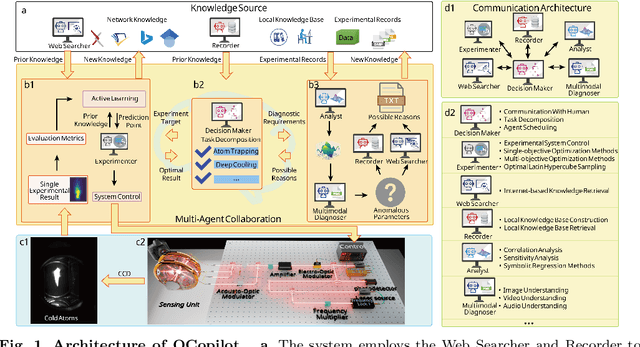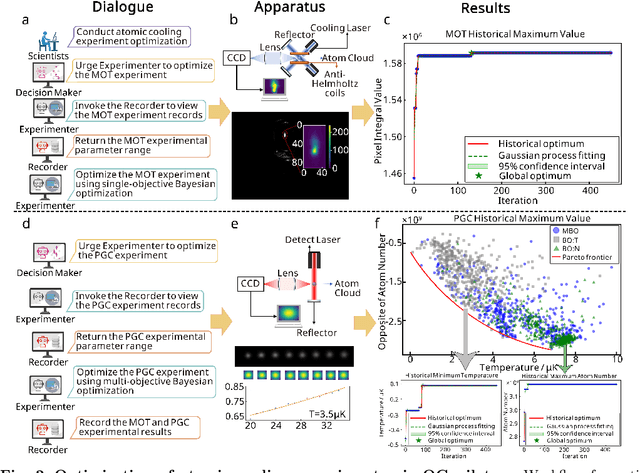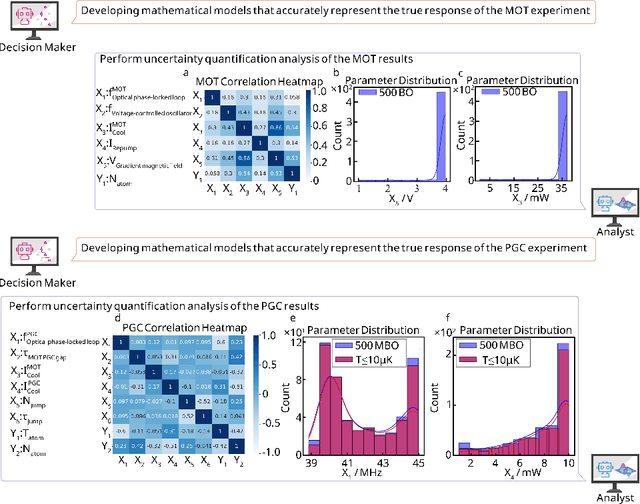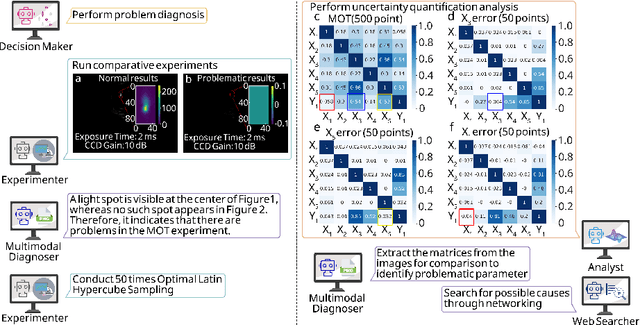Chao Zhou
Jack
Near-field Target Localization: Effect of Hardware Impairments
Dec 25, 2025Abstract:The prior works on near-field target localization have mostly assumed ideal hardware models and thus suffer from two limitations in practice. First, extremely large-scale arrays (XL-arrays) usually face a variety of hardware impairments (HIs) that may introduce unknown phase and/or amplitude errors. Second, the existing block coordinate descent (BCD)-based methods for joint estimation of the HI indicator, channel gain, angle, and range may induce considerable target localization error when the target is very close to the XL-array. To address these issues, we propose in this paper a new three-phase HI-aware near-field localization method, by efficiently detecting faulty antennas and estimating the positions of targets. Specifically, we first determine faulty antennas by using compressed sensing (CS) methods and improve detection accuracy based on coarse target localization. Then, a dedicated phase calibration method is designed to correct phase errors induced by detected faulty antennas. Subsequently, an efficient near-field localization method is devised to accurately estimate the positions of targets based on the full XL-array with phase calibration. Additionally, we resort to the misspecified Cramer-Rao bound (MCRB) to quantify the performance loss caused by HIs. Last, numerical results demonstrate that our proposed method significantly reduces the localization errors as compared to various benchmark schemes, especially for the case with a short target range and/or a high fault probability.
Position Optimization for Two-layer Movable Antenna Systems
Nov 19, 2025Abstract:Movable antenna (MA) is a promising technology for improving the performance of wireless communication systems by providing new degrees-of-freedom (DoFs) in antenna position optimization. However, existing works on MA systems have mostly considered element-wise single-layer MA (SL-MA) arrays, where all the MAs move within the given movable region, hence inevitably incurring high control complexity and hardware cost in practice. To address this issue, we propose in this letter a new two-layer MA array (TL-MA), where the positions of MAs are jointly determined by the large-scale movement of multiple subarrays and the small-scale fine-tuning of per-subarray MAs. In particular, an optimization problem is formulated to maximize the sum-rate of the TL-MA-aided communication system by jointly optimizing the subarray-positions, per-subarray (relative) MA positions, and receive beamforming. To solve this non-convex problem, we propose an alternating optimization (AO)-based particle swarm optimization (PSO) algorithm, which alternately optimizes the positions of subarrays and per-subarray MAs, given the optimal receive beamforming. Numerical results verify that the proposed TL-MA significantly reduces the sum-displacement of MA motors (i.e., the total moving distances of all motors) of element-wise SL-MA, while achieving comparable rate performance.
Neural B-frame Video Compression with Bi-directional Reference Harmonization
Nov 12, 2025Abstract:Neural video compression (NVC) has made significant progress in recent years, while neural B-frame video compression (NBVC) remains underexplored compared to P-frame compression. NBVC can adopt bi-directional reference frames for better compression performance. However, NBVC's hierarchical coding may complicate continuous temporal prediction, especially at some hierarchical levels with a large frame span, which could cause the contribution of the two reference frames to be unbalanced. To optimize reference information utilization, we propose a novel NBVC method, termed Bi-directional Reference Harmonization Video Compression (BRHVC), with the proposed Bi-directional Motion Converge (BMC) and Bi-directional Contextual Fusion (BCF). BMC converges multiple optical flows in motion compression, leading to more accurate motion compensation on a larger scale. Then BCF explicitly models the weights of reference contexts under the guidance of motion compensation accuracy. With more efficient motions and contexts, BRHVC can effectively harmonize bi-directional references. Experimental results indicate that our BRHVC outperforms previous state-of-the-art NVC methods, even surpassing the traditional coding, VTM-RA (under random access configuration), on the HEVC datasets. The source code is released at https://github.com/kwai/NVC.
MA-enhanced Mixed Near-field and Far-field Covert Communications
Nov 11, 2025Abstract:In this paper, we propose to employ a modular-based movable extremely large-scale array (XL-array) at Alice for enhancing covert communication performance. Compared with existing work that mostly considered either far-field or near-field covert communications, we consider in this paper a more general and practical mixed-field scenario, where multiple Bobs are located in either the near-field or far-field of Alice, in the presence of multiple near-field Willies. Specifically, we first consider a two-Bob-one-Willie system and show that conventional fixed-position XL-arrays suffer degraded sum-rate performance due to the energy-spread effect in mixed-field systems, which, however, can be greatly improved by subarray movement. On the other hand, for transmission covertness, it is revealed that sufficient angle difference between far-field Bob and Willie as well as adequate range difference between near-field Bob and Willie are necessary for ensuring covertness in fixed-position XL-array systems, while this requirement can be relaxed in movable XL-array systems thanks to flexible channel correlation control between Bobs and Willie. Next, for general system setups, we formulate an optimization problem to maximize the achievable sum-rate under covertness constraint. To solve this non-convex optimization problem, we first decompose it into two subproblems, corresponding to an inner problem for beamforming optimization given positions of subarrays and an outer problem for subarray movement optimization. Although these two subproblems are still non-convex, we obtain their high-quality solutions by using the successive convex approximation technique and devising a customized differential evolution algorithm, respectively. Last, numerical results demonstrate the effectiveness of proposed movable XL-array in balancing sum-rate and covert communication requirements.
LLM-based Multi-Agent Copilot for Quantum Sensor
Aug 07, 2025



Abstract:Large language models (LLM) exhibit broad utility but face limitations in quantum sensor development, stemming from interdisciplinary knowledge barriers and involving complex optimization processes. Here we present QCopilot, an LLM-based multi-agent framework integrating external knowledge access, active learning, and uncertainty quantification for quantum sensor design and diagnosis. Comprising commercial LLMs with few-shot prompt engineering and vector knowledge base, QCopilot employs specialized agents to adaptively select optimization methods, automate modeling analysis, and independently perform problem diagnosis. Applying QCopilot to atom cooling experiments, we generated 10${}^{\rm{8}}$ sub-$\rm{\mu}$K atoms without any human intervention within a few hours, representing $\sim$100$\times$ speedup over manual experimentation. Notably, by continuously accumulating prior knowledge and enabling dynamic modeling, QCopilot can autonomously identify anomalous parameters in multi-parameter experimental settings. Our work reduces barriers to large-scale quantum sensor deployment and readily extends to other quantum information systems.
Pay Attention to Small Weights
Jun 26, 2025Abstract:Finetuning large pretrained neural networks is known to be resource-intensive, both in terms of memory and computational cost. To mitigate this, a common approach is to restrict training to a subset of the model parameters. By analyzing the relationship between gradients and weights during finetuning, we observe a notable pattern: large gradients are often associated with small-magnitude weights. This correlation is more pronounced in finetuning settings than in training from scratch. Motivated by this observation, we propose NANOADAM, which dynamically updates only the small-magnitude weights during finetuning and offers several practical advantages: first, this criterion is gradient-free -- the parameter subset can be determined without gradient computation; second, it preserves large-magnitude weights, which are likely to encode critical features learned during pretraining, thereby reducing the risk of catastrophic forgetting; thirdly, it permits the use of larger learning rates and consistently leads to better generalization performance in experiments. We demonstrate this for both NLP and vision tasks.
Bridging Video Quality Scoring and Justification via Large Multimodal Models
Jun 26, 2025Abstract:Classical video quality assessment (VQA) methods generate a numerical score to judge a video's perceived visual fidelity and clarity. Yet, a score fails to describe the video's complex quality dimensions, restricting its applicability. Benefiting from the linguistic output, adapting video large multimodal models (LMMs) to VQA via instruction tuning has the potential to address this issue. The core of the approach lies in the video quality-centric instruction data. Previous explorations mainly focus on the image domain, and their data generation processes heavily rely on human quality annotations and proprietary systems, limiting data scalability and effectiveness. To address these challenges, we propose the Score-based Instruction Generation (SIG) pipeline. Specifically, SIG first scores multiple quality dimensions of an unlabeled video and maps scores to text-defined levels. It then explicitly incorporates a hierarchical Chain-of-Thought (CoT) to model the correlation between specific dimensions and overall quality, mimicking the human visual system's reasoning process. The automated pipeline eliminates the reliance on expert-written quality descriptions and proprietary systems, ensuring data scalability and generation efficiency. To this end, the resulting Score2Instruct (S2I) dataset contains over 320K diverse instruction-response pairs, laying the basis for instruction tuning. Moreover, to advance video LMMs' quality scoring and justification abilities simultaneously, we devise a progressive tuning strategy to fully unleash the power of S2I. Built upon SIG, we further curate a benchmark termed S2I-Bench with 400 open-ended questions to better evaluate the quality justification capacity of video LMMs. Experimental results on the S2I-Bench and existing benchmarks indicate that our method consistently improves quality scoring and justification capabilities across multiple video LMMs.
HIT Model: A Hierarchical Interaction-Enhanced Two-Tower Model for Pre-Ranking Systems
May 26, 2025Abstract:Online display advertising platforms rely on pre-ranking systems to efficiently filter and prioritize candidate ads from large corpora, balancing relevance to users with strict computational constraints. The prevailing two-tower architecture, though highly efficient due to its decoupled design and pre-caching, suffers from cross-domain interaction and coarse similarity metrics, undermining its capacity to model complex user-ad relationships. In this study, we propose the Hierarchical Interaction-Enhanced Two-Tower (HIT) model, a new architecture that augments the two-tower paradigm with two key components: $\textit{generators}$ that pre-generate holistic vectors incorporating coarse-grained user-ad interactions through a dual-generator framework with a cosine-similarity-based generation loss as the training objective, and $\textit{multi-head representers}$ that project embeddings into multiple latent subspaces to capture fine-grained, multi-faceted user interests and multi-dimensional ad attributes. This design enhances modeling effectiveness without compromising inference efficiency. Extensive experiments on public datasets and large-scale online A/B testing on Tencent's advertising platform demonstrate that HIT significantly outperforms several baselines in relevance metrics, yielding a $1.66\%$ increase in Gross Merchandise Volume and a $1.55\%$ improvement in Return on Investment, alongside similar serving latency to the vanilla two-tower models. The HIT model has been successfully deployed in Tencent's online display advertising system, serving billions of impressions daily. The code is available at https://anonymous.4open.science/r/HIT_model-5C23.
Accelerating Diffusion-based Super-Resolution with Dynamic Time-Spatial Sampling
May 17, 2025



Abstract:Diffusion models have gained attention for their success in modeling complex distributions, achieving impressive perceptual quality in SR tasks. However, existing diffusion-based SR methods often suffer from high computational costs, requiring numerous iterative steps for training and inference. Existing acceleration techniques, such as distillation and solver optimization, are generally task-agnostic and do not fully leverage the specific characteristics of low-level tasks like super-resolution (SR). In this study, we analyze the frequency- and spatial-domain properties of diffusion-based SR methods, revealing key insights into the temporal and spatial dependencies of high-frequency signal recovery. Specifically, high-frequency details benefit from concentrated optimization during early and late diffusion iterations, while spatially textured regions demand adaptive denoising strategies. Building on these observations, we propose the Time-Spatial-aware Sampling strategy (TSS) for the acceleration of Diffusion SR without any extra training cost. TSS combines Time Dynamic Sampling (TDS), which allocates more iterations to refining textures, and Spatial Dynamic Sampling (SDS), which dynamically adjusts strategies based on image content. Extensive evaluations across multiple benchmarks demonstrate that TSS achieves state-of-the-art (SOTA) performance with significantly fewer iterations, improving MUSIQ scores by 0.2 - 3.0 and outperforming the current acceleration methods with only half the number of steps.
Ultra Lowrate Image Compression with Semantic Residual Coding and Compression-aware Diffusion
May 13, 2025



Abstract:Existing multimodal large model-based image compression frameworks often rely on a fragmented integration of semantic retrieval, latent compression, and generative models, resulting in suboptimal performance in both reconstruction fidelity and coding efficiency. To address these challenges, we propose a residual-guided ultra lowrate image compression named ResULIC, which incorporates residual signals into both semantic retrieval and the diffusion-based generation process. Specifically, we introduce Semantic Residual Coding (SRC) to capture the semantic disparity between the original image and its compressed latent representation. A perceptual fidelity optimizer is further applied for superior reconstruction quality. Additionally, we present the Compression-aware Diffusion Model (CDM), which establishes an optimal alignment between bitrates and diffusion time steps, improving compression-reconstruction synergy. Extensive experiments demonstrate the effectiveness of ResULIC, achieving superior objective and subjective performance compared to state-of-the-art diffusion-based methods with - 80.7%, -66.3% BD-rate saving in terms of LPIPS and FID. Project page is available at https: //njuvision.github.io/ResULIC/.
 Add to Chrome
Add to Chrome Add to Firefox
Add to Firefox Add to Edge
Add to Edge